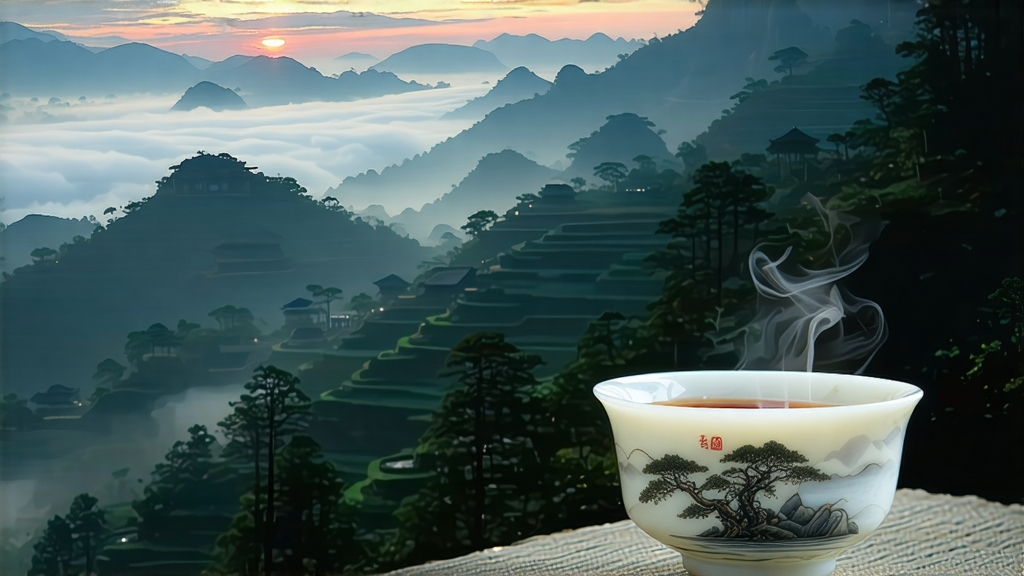
Long before Assam, Ceylon or Earl Grey entered the English lexicon, the words “bohea” and “souchong” were whispered in London coffee-houses with the reverence today reserved for grand cru Bordeaux. The tea behind those exotic syllables was Lapsang Souchong, the very first black tea ever created and the prototype that taught the world how leaf could be coaxed from verdant green to obsidian black. Born in the precipitous Wuyi Mountains of northern Fujian province during the late Ming dynasty, its origin story is equal parts accident and entrepreneurship. Legend tells of a passing Qing-era army that commandeered a village tea factory; anxious to meet the next day’s market, workers dried the leaves over fresh pine fires to accelerate the process. The resulting liquor—brisk, copper-red and laced with the perfume of resin—so delighted Dutch traders that they paid double, and a new category was born.
Today the name Lapsang Souchong (from the Fuzhou dialect la-sang, “pine village”, and xiao-zhong, “small leaf cultivar”) covers a spectrum of styles far broader than the heavily smoked, somewhat tarry version that once filled Victorian tins. Purists divide it into two families: the traditional “smoke-dried” (zhengshan xiaozhong) and the modern “unsmoked” (wuyi xiaozhong). Both spring from the same mountain gene pool—tight-rowed bushes of Camellia sinensis var. sinensis clinging to weathered tuff cliffs, their roots mining mineral-rich red sandy loam. Yet their destinies diverge at the firing stage, yielding cups that can recall either a Highland single-malt finished in Islay barrels or a silky Burgundy pinot noir.
Geography is the first guardian of character. The core “zhengshan” zone is a 600–1,200 m microclimate cupped inside a horseshoe of granite peaks where morning fog lingers until noon, humidity hovers at 80 % and diurnal swings can exceed 15 °C. These stresses slow photosynthesis, concentrating theanine and volatile aromatics while keeping tannins gentle. Only leaf picked within this 60 km² radius may legally claim the title “zhengshan”; everything else is “waishan” (outside mountain) and typically processed in lower-elevation factories that rely on imported smoke flavouring rather than authentic pine embers.
Harvest follows the Chinese solar calendar. The spring flush, qingming qian (before 5 April), yields the most tender one-bud-two-leaf sets whose downy backs look almost silvery. Summer leaf is larger, fleshier, and preferred for the boldest smoked expressions, while a small autumn picking—gu hua or “sweet flower” season—offers honeyed nuance for the unsmoked style. Pluckers work barefoot on narrow terraces, laying the baskets on bamboo slides that zigzag down to the village courtyard where withering begins.
Withering is still done the old way: bamboo racks set under skylights whose shutters are opened or closed every twenty minutes as the mountain breeze shifts. Over eight hours the leaf loses about 65 % moisture, edges turning tobacco-brown while the veins remain elastic. When the master—usually a woman whose family has monitored Wuyi weather for three generations—judges the “soft but not sticky” moment, she gathers the leaves into cloth-lined piles for the rolling phase.
Rolling is brief but crucial: 8–10 minutes in a cast-iron trough whose ribs mimic the motion of hand-kneading. The goal is to rupture 30–35 % of the cell walls, releasing catechins and polyphenol oxidase without shredding the leaf. Oxidation follows in pine-wood boxes whose temperature drifts from 24 °C at dawn to 30 °C by late afternoon. Here the magic of colour change unfolds: chlorophyll degrades into pheophytin, catechins condense into theaflavins and thearubigins, and the leaf aroma migrates from cut grass to peach, then to malt and finally to a faint suggestion of smoked apricot.
The crossroads moment arrives with firing. For traditional Lapsang, the mao cha is spread on honglong (bamboo sieves) suspended over a